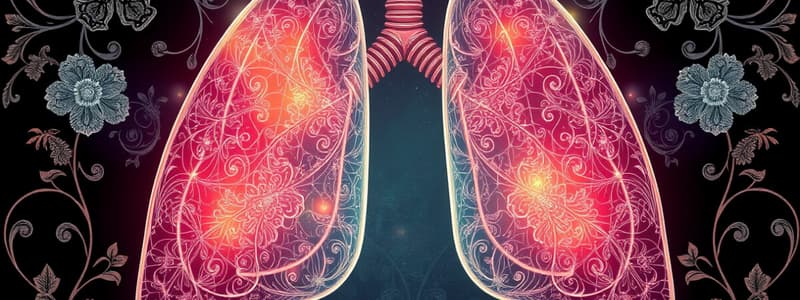Podcast
Questions and Answers
What is the primary function of pulmonary arteries?
What is the primary function of pulmonary arteries?
- Transport oxygenated blood to the heart
- Transport deoxygenated blood to the lungs (correct)
- Facilitate gas exchange in the bronchioles
- Supply nutrients to the alveoli
What is the characteristic feature of capillaries in the lungs?
What is the characteristic feature of capillaries in the lungs?
- They transport oxygenated blood exclusively
- They form a network around the alveoli (correct)
- They have thick muscular walls
- They contain valves to facilitate blood flow
Which structure has a thickness of less than 0.1μ?
Which structure has a thickness of less than 0.1μ?
- Pulmonary veins
- Capillaries (correct)
- Arterioles
- Type I squamous pneumocytes
Which part of the respiratory system contains Pores of Kohn?
Which part of the respiratory system contains Pores of Kohn?
What is the composition of the walls of venules and veins?
What is the composition of the walls of venules and veins?
Which structure is primarily responsible for the gas exchange in the lungs?
Which structure is primarily responsible for the gas exchange in the lungs?
What is the role of type II granular pneumocytes in the alveoli?
What is the role of type II granular pneumocytes in the alveoli?
Which feature of type I squamous pneumocytes is critical for their function?
Which feature of type I squamous pneumocytes is critical for their function?
What function do the pores of Kohn serve in the alveolar structure?
What function do the pores of Kohn serve in the alveolar structure?
What is the primary composition of the interstitium in the alveolo-capillary system?
What is the primary composition of the interstitium in the alveolo-capillary system?
Which of the following describes the structure and function of alveolar sacs?
Which of the following describes the structure and function of alveolar sacs?
What is the role of type III alveolar cells?
What is the role of type III alveolar cells?
How does collagen in the interstitium contribute to lung function?
How does collagen in the interstitium contribute to lung function?
Flashcards
Alveoli
Alveoli
The smallest functional units of the lungs, responsible for gas exchange, they resemble tiny balloons arranged in clusters.
Septal Walls
Septal Walls
The walls between alveoli that help separate and support them.
Alveolar Capillary Network
Alveolar Capillary Network
The network of tiny blood vessels that surround the alveoli, where oxygen enters the blood and carbon dioxide exits.
Type I Pneumocytes
Type I Pneumocytes
Signup and view all the flashcards
Type II Pneumocytes
Type II Pneumocytes
Signup and view all the flashcards
Pores of Kohn
Pores of Kohn
Signup and view all the flashcards
Alveolar Macrophages
Alveolar Macrophages
Signup and view all the flashcards
Interstitium
Interstitium
Signup and view all the flashcards
Collagen
Collagen
Signup and view all the flashcards
Pulmonary Arteries
Pulmonary Arteries
Signup and view all the flashcards
Pulmonary Capillaries
Pulmonary Capillaries
Signup and view all the flashcards
Pulmonary Veins
Pulmonary Veins
Signup and view all the flashcards
Lung Parenchyma
Lung Parenchyma
Signup and view all the flashcards
Study Notes
Functional Units of Gas Exchange
- Primary lobules, also known as lung parenchyma, encompass respiratory bronchioles, alveoli, alveolar ducts, and alveolar sacs.
- Respiratory bronchioles consist of four generations that conduct air and partake in minimal gas exchange.
Alveoli and Structures
- Alveoli are tiny balloon-like structures, the primary sites of gas exchange, separated by septal walls, and represent the terminal portion of the respiratory tree.
- Alveolar ducts connect respiratory bronchioles to alveolar sacs and consist of four generations.
Alveolar Sacs
- Clusters of 15-20 alveoli form alveolar sacs, resembling grape-like structures that maximize surface area for gas exchange.
Pneumocyte Types
- Type I squamous pneumocytes make up about 95% of the alveolar surface, essential for efficient gas exchange due to their broad, thin design (thickness: 0.1μ to 0.5μ).
- Type II granular pneumocytes produce surfactant, preventing alveolar collapse and assisting in the repair of the alveolar epithelium.
Pores of Kohn
- Pores of Kohn, with sizes ranging from 3μ to 13μ, are small openings in the interalveolar septa that facilitate gas movement between adjacent alveoli, crucial for maintaining even gas distribution.
Alveolar Macrophages
- Type III alveolar cells, also known as alveolar macrophages, perform phagocytosis of foreign particles and pathogens, playing a protective role in maintaining lung health.
Interstitium
- The interstitium serves as a gel-like support for the alveolo-capillary system, comprised of collagen fibers and extracellular matrix components, which aids in structural support and tissue repair.
Collagen and Alveolar Distensibility
- Collagen in the interstitium grants tensile strength and limits alveolar stretching, thereby preventing capillary occlusion.
Pulmonary Circulation
- Pulmonary arteries transport deoxygenated blood from the right ventricle to the lungs, traversing through the hilum and following the tracheobronchial tree.
- Arterioles provide nutrients to respiratory structures and consist of three layers: endothelial, elastic, and smooth muscle, which diminish prior to entering the alveolar-capillary system.
- Capillaries, less than 0.1μ thick, constitute the primary site for gas exchange, forming a network around alveoli while also playing roles in biochemical processes.
Pulmonary Venous System
- Venules and veins extend from arterioles, leading to pulmonary veins, characterized by three tissue layers, diminished smooth muscle and elastic tissue, and flap-like valves to facilitate blood return to the heart.
Alveolar Statistics
- The human lungs contain approximately 300 million alveoli, each measuring between 75μ and 300μ.
Studying That Suits You
Use AI to generate personalized quizzes and flashcards to suit your learning preferences.
Description
Explore the vital components of the respiratory system in this quiz, focusing on structures distal to the terminal bronchioles. Learn about respiratory bronchioles, alveoli, and their roles in gas exchange and lung function.




